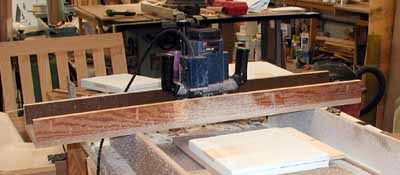Routing Fin
 |
Here is a jig used to create half scale fins for a Nike booster. These fins are roughly 1 inch thick at the root and ½ inch at the tip. The jig, used with a router, cuts the taper and bevel perfectly, (no sanding) and is very easy to make.
First cut 4 pieces of ¾" MDF about 12" x 24". Locate the center and drill a ¼" hole in 2 of the pieces.
Take one piece with the hole and one of the other ones and lay them on top of each other. Install a length of piano hinge along the long side of the 2 pieces, do the same with the other 2 also.
Counter bore one of the holes on the inside so a bolt can be inserted and the pieces can still close.
Insert the bolt from the first table assembly into the second table assembly and Presto! A compound table for milling operations.
To use you need a set of rails to run your router on. I cut two pieces of MDF about 3" x 36" and two pieces about 6" x 36". Butt joint them to form an L. I have an old solid core door that I use for a bench that I screwed the rails to along each edge. Position the tables between the rails and the jig is complete.
Attach the router to another piece of MDF to run across the top of the rails.

With the tables positioned at 90 degrees to each other, the fin material is attached using double sided carpet tape. Shims are inserted into one of the tables to create the taper. Once all 4 fins are tapered the other table is raised to cut the bevel. Cut one edge then rotate the tables 180 degrees to cut the other edge. The sweep of the leading and trailing edges will automatically be cut by the router when you complete the other side. So you can just start out with a square block of wood. (mine are a combination of ½" Baltic Birch plywood and Styrofoam to save weight)
Fiberglass the completed side of the fin and reinstall it in the jig. This time you will need to readjust the table angle for the taper to twice the original angle. Taper all of the fins then begin the beveling process, this is where the sweep angle is automatically cut.
Two problems encountered when cutting the second side were that the tape did not want to stick to the raw fiberglass very well and the leading and trailing edges tended to flutter under the router bit as all that was necessary was two layers of 6 oz cloth on the foam in that area. A simple solution to both problems would be to stick the fins to another board, such as ¼ inch plywood or Masonite and pack some Bondo under the fins in the area where the leading edges and trailing edges will be cut. This will act as a temporary adhesive and will stiffen up the edges while cutting them. The Bondo can be chipped off and the remainder easily sands off.

Submitted by: Mark Mazzon
